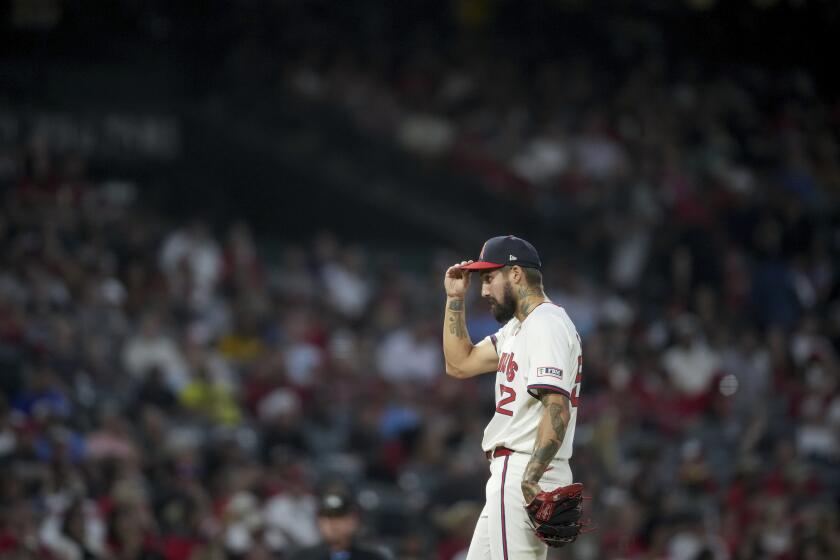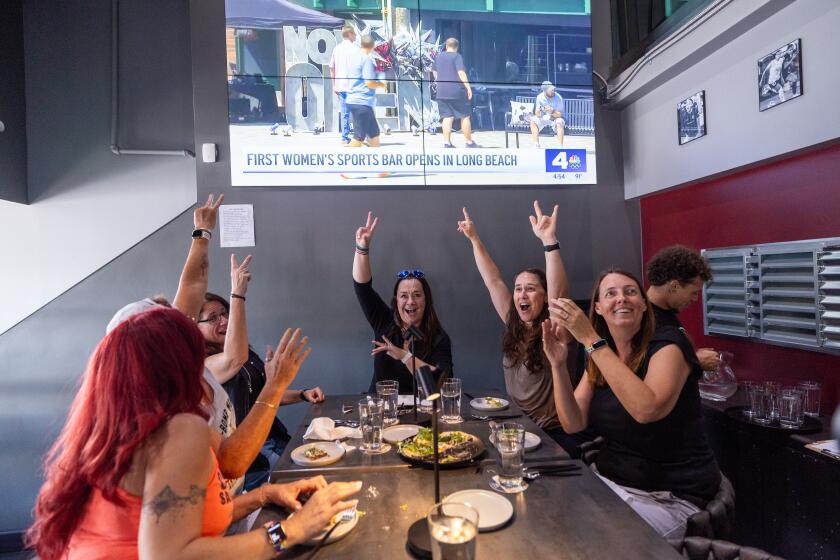They Sought an Opening : On Recent Day at Riviera, 60 Golfers Pursued Dream of Playing in U.S. Open
There was a reason the clubhouse bar at Riviera Country Club was doing such brisk business last week.
It was the same reason one young golf pro nearly went berserk after his round, yelling, “Damn!” while angrily kicking at the pavement with his golf spikes and then, with another vicious swing of his leg, scattering a small crowd assembled around the scoreboard.
It was also why Jim Detrixhe stood in the pro shop at day’s end and watched in wonderment as club officials showered him with gifts: A new bag . . . shirts . . . visors . . . golf balls . . . anything he wanted. And why George Daves and his wife, Kelli, happily clinked their drink glasses together as they sat looking out onto the Riviera course.
The reason: The lure of the U.S. Open.
Late last Tuesday, the final five entrants for this year’s Open, starting Thursday at Hazeltine National Golf Club in Chaska, Minn., were determined by the age-old method of sectional qualifying rounds. Sixty golfers. Thirty-six holes. Five openings. Countless heartaches. The grueling ritual was played out at four other clubs earlier that day in other parts of the country.
Relatively speaking, you need only $75 for the application fee and a United States Golf Assn. handicap index of 2.4 or better to try to qualify for the Open. But in reality, you need much more. You need a swing designed for pressure, nerves tempered by experience and legs strong enough to walk 36 holes. A little luck doesn’t hurt, either.
On qualifying day at grand old Riviera, 50 professionals and 10 amateurs, all of them survivors of last month’s local qualifying process, took turns chasing a dream. Here are six of their stories: DARRYL COURT Tulsa, Okla.
The light was blinking on Court’s answering machine when he returned home from dinner on Friday, May 31. It was 11 p.m.--far too late for a return call--but Court decided to listen to the message anyway.
“Uh, yes, this is R. James Unruh of the USGA Sectional Affairs Committee,” began the message. “We’d like to offer you a place in the U.S. Open sectional qualifying.”
The improbable had happened. Bob May, an Oklahoma State star, had been forced to choose between the sectional qualifying or the NCAA golf tournament. May chose the NCAA tournament, leaving a spot for the first alternate in the local qualifying, who happened to be Court.
There was only one catch: If Court wanted to play, he would have to travel to Los Angeles, which is where May was scheduled to compete. Court, who was the first alternate in the local qualifying rounds a year earlier, couldn’t say yes fast enough. So what if he hadn’t played in a week? This was a chance at the U.S. Open.
By 11:30, he had made reservations for a $470-round-trip ticket. By 12:15 the following Sunday afternoon, he was at LAX. By 3 p.m., he was on the first tee at Riviera, preparing to play a practice round.
Like many young pros, Court has struggled to build a career. A graduate of the University of Tulsa, Court has played on mini-tours in the United States and Australia. He tried to earn his PGA card last year but failed at the qualifying school. He said he will try again this season.
But first, there would be this matter of qualifying for the U.S. Open. So late an entry was Court that his name was not on the pairings sheet. Even on the scoreboard, his name was hurriedly scrawled in blue marker, whereas everyone else’s was printed neatly in black ink.
Court didn’t care. He was here, wasn’t he?
Things did not go well for Court, though. His first-round score of 79 all but eliminated him from the chase. An afternoon round of 72 was much better but hardly good enough to get him one of the five prized spots.
“I really hadn’t prepared,” he said, shortly before paying his caddie $120 for two rounds’ worth of bag toting. “But I wanted to try.”
And then he was off. Back to Tulsa. Back to the grind. If nothing else, Court said as he headed toward his rental car, there always would be a story to tell his children one day. The story of the first time he and Riviera met. BOB LASKEN Whittier
The way Lasken figured it, Riviera owed him.
While trying to qualify for this year’s Los Angeles Open, played on the famed course, Lasken shot an impressive seven-under-par score--a lock, he thought, for a spot in the tournament.
“I’ve shot seven under maybe 15 times in my life,” he said. “I mean, it was a really good round.”
Too bad. Someone else was eight under par, squeezing Lasken, who was captain of the 1988 UCLA national championship golf team, out of the field.
So naturally, when he finished sectional qualifying at 143--good enough, it appeared, to qualify for the U.S. Open, Lasken was suspicious. When friends slapped him on the back, telling him, “You’re in! You’re in!” he pleaded with them to stop.
“Don’t jinx me,” he said.
For 2 1/2 hours, Lasken waited for the remaining threesomes to finish their afternoon rounds. He paced. He putted. He thought about the videotapes he watched the night before--one of last year’s British Open, one of last year’s U.S. Open and one of this year’s Masters.
He also tried not to consider the possibilities, but it was impossible. There were three options: He could earn a place outright. He could be forced into a playoff. He could get bitten by the curse of Riviera again and lose to a couple of strong finishers.
At about 6:20 p.m., moments after the final scores were registered on the leader board, came the news: There would be a playoff.
Three players--Lasken, Brad Sherfy, who also played at UCLA, and former L.A. Open winner T.C. Chen--would compete for the final two places in the U.S. Open field. Lasken, 25, knew Sherfy and Chen from the Asian Tour. In fact, Chen once invited Lasken to his Taiwan home for dinner. Now they were assembled on the first tee, exchanging handshakes and telling one another, “Good luck.”
This was Lasken’s fifth attempt at qualifying for the Open. He had come closest five years ago, when he needed to par the final three holes to advance to Shinnecock Hills in Southampton, N.Y. He missed by two strokes. But maybe this year would be different. To advance to the sectional at Riviera, Lasken holed about a 40-yard bunker shot on the 18th hole of the difficult Babe Zaharias course at Industry Hills.
“Hey, there’s got to be some kind of fate there,” Lasken said.
Lasken wanted to hit first in the playoff. Instead, he drew the third spot. So much for fate.
All three drives landed on the fairway of the par-five, 501-yard first hole. Chen pulled out a one-iron and pushed his shot slightly to the right and short of the green. Sherfy and Lasken reached the green in two.
Needing to get close to the pin, Chen pitched to the green and watched in disbelief as the ball checked up and quit rolling about seven feet from the hole.
Lasken and Sherfy needed only to two-putt for birdies, which is easier said than done when playing for a U.S. Open spot. Lasken went first, lagging the putt about two feet from the cup and sank his birdie putt. Sherfy was next. His putt trickled past the hole and didn’t stop until it was five feet past.
Now came Chen’s turn. As Chen stood over the putt, Lasken motioned to his own caddie, as if to say that he expected the ball to drop for a birdie. Chen putted. . . . The ball moved toward the hole. . . . And then, an inch or two from the cup, it stopped.
Moments later, Sherfy knocked in his putt, and the playoff was over.
Sherfy hugged his wife. Lasken shook hands with his friends. Chen stood on the green alone, staring at the cup. Before leaving, he dropped a ball to the ground and putted once more. This time, he missed by two feet.
There was little time, though, for Lasken to celebrate. He had to drive to Palm Springs for a Golden State Tour event and then start figuring out a way to pay for his trip to Hazeltine.
“I guarantee you, the club (Candlewood) will pick up part of the costs,” said a friend, as Lasken walked back to the clubhouse.
Funny thing about Candlewood. That night, the members were supposed to vote on Lasken’s club application. He was pretty sure he’d made it. MATHEW TODD Visalia
By virtue of his victory in the U.S. Junior Amateur tournament, Todd received an exemption from local qualifying and was given a place in the sectional. Only 18 and a day away from graduating from Redwood High School, Todd didn’t like his chances of earning an invitation to Hazeltine.
“I’m a nobody, basically,” he said. “I’m just here to learn where I am in the big swamp. Right now, it seems like I’m algae, maybe a protozoan.”
Todd had just shot a 78 in the morning round. Despite the disappointing score, he talked happily about the experience during a lunch break. His mother, who accompanied him on the four-hour drive from Visalia, waited outside the dining room.
“I probably won’t qualify,” he said. “But this will help me mentally.”
Todd’s problems in the early round were in course management. Of course, Riviera can do that, especially to one as young as Todd, who never set foot on the course until Sunday’s practice round.
“Thank God, I’ve got a real good caddie,” he said. “I just didn’t listen to him. I’m paying this guy money, so I should listen to him, right?”
As expected, Todd didn’t qualify. His afternoon round of 75 was a moral victory of sorts, but little else. But if Todd was upset with the effort, he didn’t show it. Instead, he was all smiles as he considered the day’s events.
“I’ll just put the experience under my belt,” he said.
Although his 153 total was 10 shots short of a playoff, Todd decided it was time to upgrade his status in the “big swamp.” No more algae. After his play at Riviera, Todd proclaimed himself “a minnow.”
Congratulations. He earned it. JIM DETRIXHE Los Angeles
Just to be on the safe side, Detrixhe, a former USC player who turned professional in 1986, recently decided to take the law school entrance exams. After all, he was 31, had not qualified for the Open in three previous tries and was getting weary of the mini-tours and overseas tours. Perhaps it was time to quit golf.
Then Detrixhe got his test scores: Not bad, but not good. Then he won a Golden State Tour event about a month ago and followed the performance with a good showing in the local qualifying at Mission Hills Country Club in Rancho Mirage. Better yet, the sectional would be played at Riviera, where he has been a member since 1974. By his own estimate, Detrixhe had played more than 500 rounds on the course.
“I guess I had a little more incentive,” he said.
After qualifying for the sectional, Detrixhe played several practice rounds last week. He couldn’t remember ever being more nervous. And then--even Detrixhe can’t explain why--the jitters disappeared. Even when he locked himself out of his apartment on the eve of play, didn’t get more than five hours of sleep and showed up to find a small gallery of Riviera members and workers to cheer him on, Detrixhe stayed surprisingly calm.
It showed. He shot a tournament-leading 69 in the morning round and gave himself a 50-50 chance to make it to the Open. After shooting another 69, Detrixhe acknowledged the obvious: He was a lock to make it.
When he completed his round, Detrixhe tipped his cap to friends, posed for several photographs and later accepted the USGA medal for the day’s low total of 138.
“I’m going to be rubbing elbows with the big boys,” he said. “And I thought there was pressure here.”
And just in case he does poorly at the Open?
“I’m still thinking about law school,” he said. RAY CARRASCO Laguna Hills
In 1981, when Carrasco qualified for his first U.S. Open, he found himself with one of those prized entry forms, but no way to pay for his trip to the Merion Golf Club in Ardmore, Pa. Word got out, and soon one of his golf pupils, 9-year-old Mike Sharp, gave Carrasco a piggy bank filled with about $6 worth of pennies.
“And I kept it,” Carrasco said.
Ten years later, Carrasco isn’t so desperate for money as he is for another invitation to the Open. He qualified in 1983 when the tournament was held at the Oakmont Country Club in Oakmont, Pa., but since then has been unable to get past the sectionals.
To the rescue--again--came Sharp, now 19 and a member of the Orange Coast College team, and Sharp’s father, Gil. When Carrasco, head teaching pro at Laguna Hills Golf Range, teed off for another try at the Open, the Sharps and several other friends were his gallery.
Carrasco, 44, has been a professional golfer for 20 years. He has played on four continents and in countless mini-tour events. Golf isn’t merely his livelihood, it’s his passion. How else could you explain his appearance at Riviera for his 15th try at a U.S. Open spot?
“Normally, I’d be giving lessons from sunup to sundown,” he said. “To me, this is a vacation.”
He has played in the British Open, but it is the U.S. Open that has always fascinated him. And this year more than any, Carrasco wanted to qualify and then record one of the top 15 scores at Hazeltine. If he could, he would receive an automatic exemption for the 1992 tournament, which will be played at his favorite course, Pebble Beach. A long shot, to be sure, but what else are dreams for?
Carrasco is familiar with Riviera. After a dozen rounds on the course, he has seen what its subtly shaped greens can do to a simple putt.
“You’ve got to know how they break here,” he said.
Carrasco finished his morning round with a one-over-par 72. His friends figured that an afternoon round of 71 or 70 would be enough for Carrasco to qualify.
The second round did not start well, though. His caddie became ill on the second hole, and Carrasco had to enlist a friend to carry his bag. After nine holes, he was four over par for the tournament.
“We’re going to root him on to about a 31 on the back side,” Gil Sharp said.
No such luck. Carrasco limped in with a 79.
“My concentration slipped a bit,” he said. “My problem is that I’ve only been playing once a week.”
Carrasco gathered his things and made a promise to try again next year. The Open does that to people. GEORGE DAVES Medford, Ore.
It is a 12-hour drive from Medford to Los Angeles, and Daves didn’t mind a minute of it. He hadn’t expected to advance to the sectional qualifying, so a trip to Riviera was a pleasant surprise.
A spot in the Open? Well, Daves, who hadn’t played competitive golf since last November, knew better than to hope for the impossible.
A 1987 University of Oregon graduate, Daves turned pro after college, but later decided he could make more money selling real estate. He tried qualifying for the Open two other times, “but I’ve never even been close,” he said. In fact, one of the main reasons he spent $75 on an entry fee this year was to play Riviera.
He not only played it, he played it well and earned a place on the pairings list for the Open. A morning round of 69, followed by a 71, which included a birdie chip on No. 18, saw to that.
“Great fun,” he said.
More to Read
Go beyond the scoreboard
Get the latest on L.A.'s teams in the daily Sports Report newsletter.
You may occasionally receive promotional content from the Los Angeles Times.






